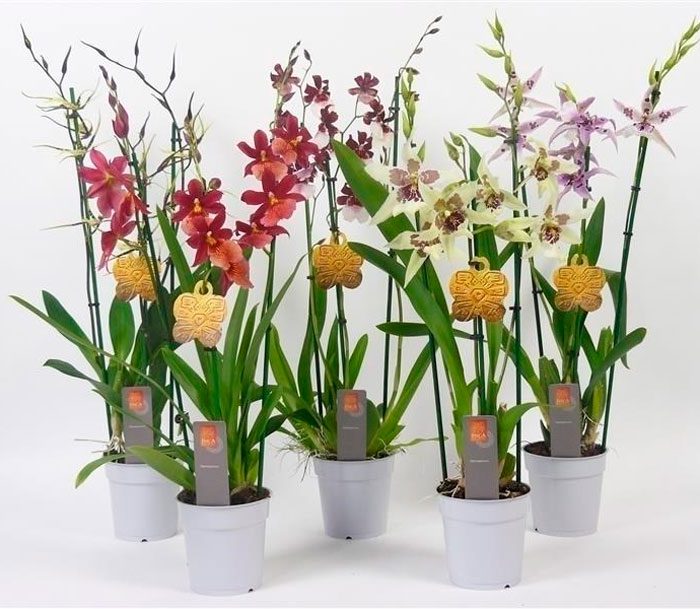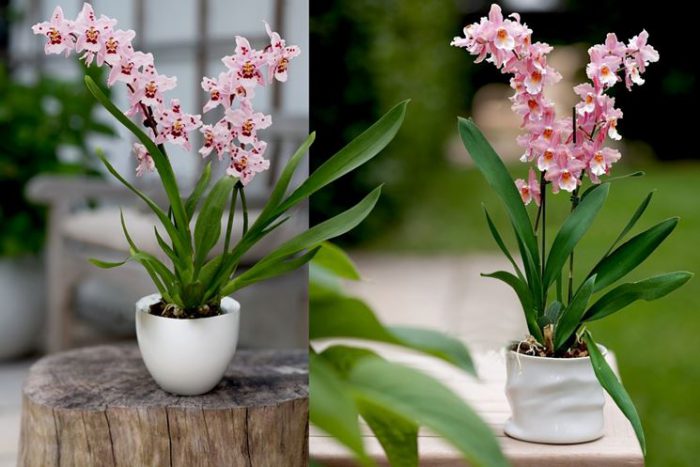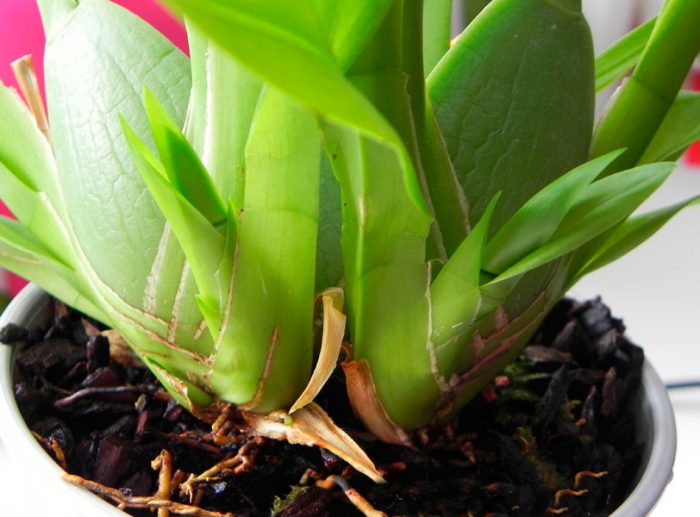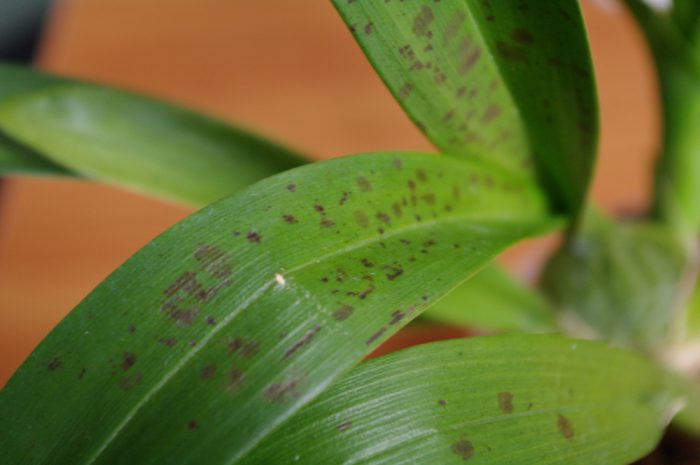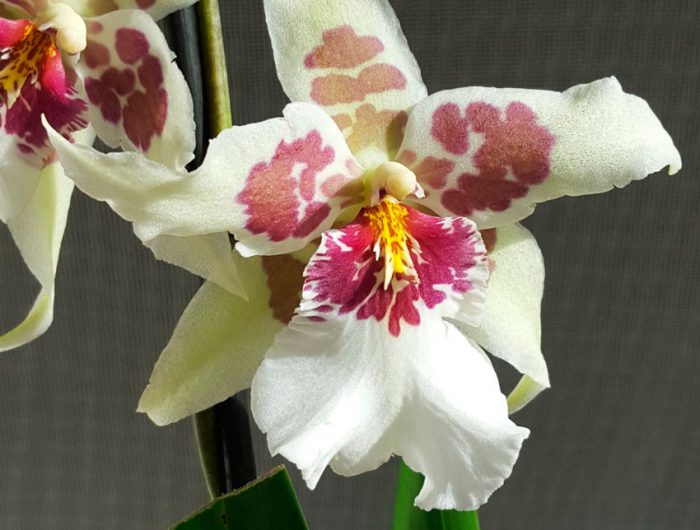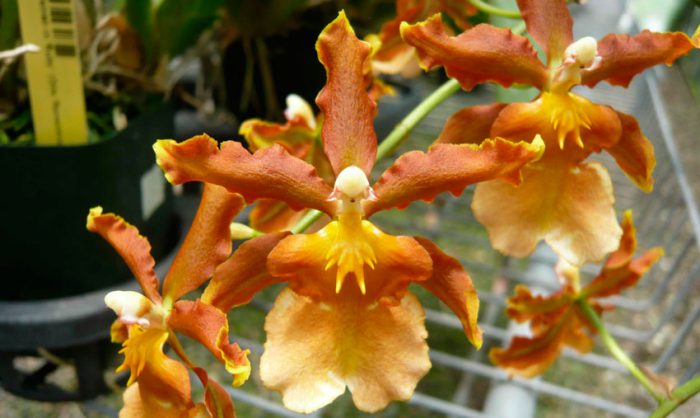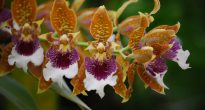Cambria is a trade name of a fairly numerous genus, the representatives of which are considered to be hybrids created by crossing plants from such genera as brassia, miltonia, odontoglossum (Odontoglossum) and some others. Also in flower shops, such a plant is often called Aliceara, Bakerara, Beallara, while in the scientific literature it is called × Degarmoara.
Plants of this genus have a sympodial growth pattern. So, the growth of young shoots occurs on a horizontal shortened stem (rhizome). As it grows, old shoots die off. Oval developed pseudobulbs have a fusiform or flattened shape. On the surface of the thin roots there is a layer of velamen, which has a porous structure. From the top of the pseudobulbs, 2 or 3 green leaves grow, which reach 50 centimeters in length and have a belt-like or broad-lanceolate shape. On the surface of the leaf, the central vein is clearly visible, while the leaf blade itself is slightly folded inward along it.
Such an orchid can bloom at any time of the year. Multi-flowered peduncles appear from the axils of the lower leaves, most often they are straight, but sometimes they are branching. In length, such peduncles can reach 60 centimeters, they accommodate up to 50 relatively large flowers (up to 7–10 centimeters in diameter). Zygomorphic flowers have 5 sepals, which are connected in the shape of an asterisk, and they also have one clearly distinguishable and rather large lip (modified petal). The color of the flowers can be different, but for the most part it is variegated (specks, streaks, specks or patterns). Some of the flowers are quite scented.
Caring for the cambria orchid at home
Caring for orchids is not as easy as, for example, dendrobiums or phalaenopsis... However, if you have several skills and know the basic rules of care, then you can safely grow this beautiful flower at home.
Illumination
It needs bright lighting, but the plant needs to be shaded from direct sunlight. It will feel best on east and west facing windows. If the cambria is placed on the south window, then it should be slightly shaded from the scorching midday sun rays.
In winter, the plant will need to be highlighted with special phytolamps.It should be borne in mind that daylight hours during this period must have a duration of at least 10 hours.
Temperature regime
The plant requires a uniformly moderate temperature regime all year round from 18 to 25 degrees.
Cambria has one significant feature, so, it does not need daily temperature changes in order for the formation of flower buds to occur.
Earth mix
To grow this kind of orchid in a pot, you will need a special soil mixture. Its most important components are: crushed sphagnum and fine-grained pine bark. In order to prevent acidification, which occurs due to the decomposition of the bark, not very large pieces of charcoal should be added to the soil mixture. And for better aeration, you can use small expanded clay, peat chips or pumice. It happens that small pieces of foam are added to the substrate for better air permeability, but this is not very convenient, since when watering by immersion, this light material does not sink and floats on the surface of the water.
When planting such a plant, you need to be very careful with its delicate roots. At the very beginning, the entire root system should be lowered into an empty container and only after that, carefully add the finished soil mixture. When the orchid is planted, sphagnum moss should be laid out on the surface of the substrate in a not very thick layer. It will prevent rapid evaporation of moisture.
There is also another very important subtlety. Before pouring the bark into the pot, it must be boiled several times (2 or 3). This removes excess resin, and the pieces are well saturated with moisture.
How to water
Watering such a flower is recommended by immersion. Water is collected in a basin and a container is lowered into it (it should be completely immersed) with an orchid. After 20 to 30 minutes have passed, the pot should be removed. During this time, the porous velamen covering the surface of the roots is saturated with moisture. The flower is put in place only after all the excess liquid has drained.
There is an opinion among flower growers that the orchid is very fond of moisture, but with all this, it should not be poured. The fact is that very often, due to excess moisture, the roots begin to rot, and this often entails the death of the plant itself. To prevent this, it is necessary to water the cambria only after the bark is completely dry.
For irrigation, use extremely soft water at room temperature, which must be well settled. In the event that the water from the water supply system is of poor quality, then mandatory filtration is required before using it for irrigation.
Air humidity
This kind of orchid does not need high humidity. In order for it to feel good in room conditions, only 35 percent humidity is required. It is very easy to maintain this level of humidity. So, the top layer, consisting of moss, must be systematically moistened from a sprayer, and it is also recommended to place an open container with liquid in the immediate vicinity of the flower.
Fertilizer
Top dressing is carried out only during the growth and maturation of pseudobulbs once every 2 weeks. To do this, use a special fertilizer for orchids.
Transplant features
Such a plant has an extremely negative attitude towards transplants. In this regard, this procedure should be carried out only if absolutely necessary, when it ceases to fit into the container. When transplanting cambria, it is imperative to take into account the nature of growth, or rather, where the next young sprout will appear. Therefore, the flower is planted by pressing it against the edge of the container so that the young pseudobulbs have the maximum amount of free space. It should not be forgotten that the growing rhizome has a "ladder-like" rise.
For those plants that have grown very strongly, you can remove pseudobulbs that have dried, turned yellow, or are old enough.
Reproduction methods
For the reproduction of cambria, a method of dividing the rhizome into parts is used.It should be borne in mind that on each plot there should be 2 or 3 mature pseudobulbs, which also have a strong root system. Chopped charcoal is used to process the cut sections. After the sections are dry, the plants are seated in separate containers. The first watering should be done only about 7 days after planting.
Pests and diseases
This plant is quite resistant to harmful insects, but sometimes it settles on it spider mite... If pests are found, give the flower a warm (about 45 degrees) shower.
The plant is sick most often due to violations of the rules of care:
- Rotting pseudobulbs and root system - a lot of moisture, inappropriate soil mixture, low air temperature. As a result, the flower may die.
- Cambria does not bloom - too hot or not enough light.
- Young leaves grow folded "accordion" and over time do not straighten - too hot or too low humidity.
The folded leaves do not lead to serious problems, but they spoil the appearance of the cambria. The fact is that the surface of young leaves (and peduncles) is sticky. In air, such a surface dries quickly enough, and therefore the leaf cannot fully straighten.
Also, small black dots very often appear on the surface of the foliage. The fact is that all groups of oncidium hybrids are susceptible to fungal diseases. At the same time, already infected specimens are very often offered in flower shops. Cambria cannot be cured of this disease, but it does not affect the growth and development of the flower.
Life cycle
Because of the pseudobulbs, this plant has a clearly defined life cycle, which is reflected in their condition. Among the many types, you can often find a process that has the following description. Before flowering begins, young pseudobulbs get fat, filling up with juice, and after that they freeze, and after a while peduncles appear from the axils of the leaves. When flowering ends, the pseudobulb becomes shriveled and gradually dries up. However, a young sprout forms near its base, and this process is repeated again.
Video review


Watch this video on YouTube
Main types
Below will be listed those species that are most popular with flower growers and they can be safely purchased at a flower shop and grown in your apartment.
Vuylstekeara
It is a complex hybrid obtained by crossing Cochlioda, Miltonia and Odontoglossum. This graceful orchid on a peduncle can have from 5 to 20 flowers of a fairly large size, which are most often colored red, pink or yellow. It blooms for a long time, about 8 weeks. Flowering begins at the end of the winter beginning of the spring period.
Burrageara
This hybrid is even more complex than the previous one. It was created by crossing plants from the genera Cochlioda, Oncidium, Miltonia and Odontoglossum. The color of the flowers is a variety of combinations of red and yellow shades. The flowers are quite fragrant and their scent is similar to a rose. Flowering occurs in the middle of winter.
Beallara
This hybrid is obtained by crossing brassia, odontoglossum, miltonia, and cochliodes. Flowering is observed from mid to late summer. The flowers are cream-colored or pink-white-purple, as a rule, on their surface there is a very large number of various dots and specks of dark color.
Colmanara
This hybrid appeared as a result of crossing oncidium, odontoglossum and miltonia. The plant blooms for a long time, 1-3 months. The main color of the flowers is various shades of yellow and red.
Degarmoara
This hybrid was the result of crossing odontoglossum, brassia and miltonia. It has flowers of a rather large size, so their diameter can reach 10 centimeters. Flowering can begin at any time, and it depends on the maturation of the pseudobulbs. Flowers can have a wide variety of shapes and colors.
Odontocidium (Odontocidium)
This hybrid is quite simple and it is obtained by crossing oncidium and odontoglossum. On long peduncles there are up to 50 medium-sized flowers. Flowers can be painted in a wide variety of combinations of yellow and red, with a variety of dark patterns and dots on their surface.
Odontioda
This hybrid is also not difficult. It is obtained by crossing odontoglossum and cochliode. The color of the flowers is a variety of combinations of yellow and red flowers.

